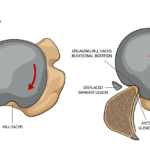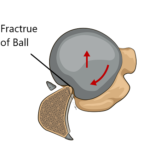Overview
Why do patients and athletes experience a shoulder dislocation despite having undergone arthroscopic shoulder stabilization surgery?
Several risk factors are associated with redislocation after arthroscopic shoulder stabilization surgery.
- Young age
- Repeated dislocations prior to surgery
- Participation in collision sports
- Bone Loss !
Research has demonstrated that young collision athletes with bone loss have an 87% failure rate with standard arthroscopic stabilization surgery compared to 6.5% failure rate when there is no bone loss. (Burkhart & De Beer, Traumatic glenohumeral bone defects and their relationship to failure of arthroscopic Bankart repairs)
Therefore, bone loss which is also referred to as bone deficiency is considered a major risk factor for redislocation after arthroscopic surgery.
What is bone loss?
When the shoulder dislocates, the typical injury pattern is labral tearing and stretch of the capsular ligaments. However, the dislocation may also create a loss of bone on both the ball and the socket. The one loss on the socket, medically referred to as the glenoid, is analogous to a golf tee that is broken. (Figure 1)
On the ball, medically referred to as humeral head, the dislocation can cause a dent or impression into the bone that is referred to as a Hill-Sachs lesion. Figure 2) The bone of the humeral head is oftened considered like Styrofoam, and can be dented easily.
Figure 3 shows an illustration and a cadaver with both a glenoid bone defect and Hill Sachs lesion that leads to dislocation.
Does a single dislocation create bone loss?
From MRI studies, Glenoid and Humeral Bone Loss can occur a single and first time dislocation
- Glenoid: 41% of 66 pts with first time dislocation (Griffeth et al, Am J Roentgenol, 2003)
Humerus Bone Loss
- Hill Sachs lesion: 67 to 81% with first time dislocation (Antonio et al, J Mag Reson Imaing 2007, Griffeth et al, Am J Roentgenol, 2003)
When bone is evaluated during arthroscopic surgery, the incidence is even higher
Calandra et al, Arthroscopy 1993
Norlin et al, Arthroscopy 1993
Yiannakopooulos, Arthroscopy 2007
Therefore, current evidence suggests that Bone Deficiency can Occur with First Time Dislocation
Latarjet Success
What is the management of bone loss if arthroscopic surgery does not work or if bone loss is recognized prior to arthroscopic surgery?
Answer: The Latarjet procedure.
Published research and my experience is that having a dislocation after Latarjet is uncommon 0-10%. The average failure rate in the literature is 2.7%.
How is bone loss measured?
Both MRI and CT scan are used to measure bone loss as sow in Figures 4.
What is the Latarjet Procedure?
The Latarjet procedure is an open surgery that takes bone from the shoulder called the coracoid process and transfers the bone to the glenoid socket. This solves the bone deficiency by adding bone to the glenoid and also adds dynamic muscle forces to help stabilize the shoulder. (Fig 5)
Why does the Latarjet procedure work?
- The addition of bone extends the glenoid.
- The Subscapularis muscle is positioned to dynamically resist dislocation
- The coracobrachialis and short head of biceps muscles are positioned to dynamically resist dislocation
Is it ok to move the coracoid, and the muscles attached to it?
Yes. The muscles still function at the arm and shoulder while protecting the shoulder from dislocating.

















